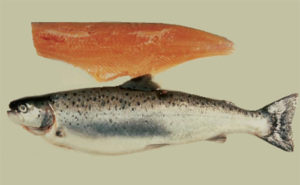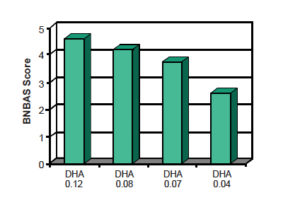Naturally higher DHA levels in human milk associated with infants’ cognitive abilities

Interest in the fatty acid composition of human milk has grown recently due to research that indicates the importance of long-chain polyunsaturated fatty acids such as docosahexaenoic acid (DHA) in the development of infants’ brains and retinas. Fatty acids like DHA, however, are some of the most variable constituents in human breast milk, for the fatty acid composition is affected by both the long- and short-term dietary intakes of the mother.
In general, the DHA content in breast milk is low in areas where fish consumption is low in comparison to areas where fish consumption is high. In the United States, many lactating women have diets that do not contain optimal amounts of seafood, resulting in DHA intake that is less than 20 percent of the recommended levels.
DHA content of breast milk
The total lipid concentrations of DHA in breast milk have been reported as 0.07 to 2.78 percent in different parts of the world. Low mean values are found in milk from mothers in Sudan, and high mean values are found in milk from mothers in a coastal area of China where fish intake is high.
Infant formulas are fortified with DHA at 0.15 to 0.32 percent, values that are actually higher than those in the milk of some mothers. Suboptimal levels of DHA are found in the breast milk of women in both developed and developing countries.
As part of two studies on infant behavior, the authors’ research group analyzed the fatty acid composition of breast milk from subjects living in an inland area of Texas, USA, where seafood consumption is low. The mean DHA content was 0.08 percent ± 0.01 in one study and 0.08 percent ± 0.04 in the second study. Of the 27 women who participated in one of the studies, only one had breast milk with the 0.35 percent of lipids level of DHA recommended by a National Institutes of Health expert panel.
On a food frequency questionnaire, only six of the 27 subjects reported that they consumed fish more frequently than rarely. Two ate 3 to 5 servings per year, three consumed 1 serving per month, and only one ate 2 to 3 servings per month. So the finding of below-optimal levels of DHA in milk from most of these mothers is not surprising. No subjects in the study reported taking fatty acid or oil supplements.
DHA and the brain
A mother’s seafood consumption is highly correlated to her DHA status and that of her infant. Docosahexaenoic acid is an integral part of brain cell membranes that may impact synaptic transmission during the critical period of brain development which occurs in late pregnancy and early infancy. In the last trimester of pregnancy and the first few months of life, the human brain undergoes a rapid growth spurt, increasing rapidly in mass and DHA content. It is estimated that during the third trimester fetuses accumulate about 67 mg of DHA daily.
DHA and infant behavior
A number of studies have examined whether infants’ intellectual development is benefited by exposure to DHA, but there has been little research regarding the effects of exposure to the variable levels of DHA in breast milk. Further, while most studies reported results supporting the benefits of early DHA exposure, more research is needed regarding different sources of DHA.
Infant formulas are typically supplemented with DHA derived from microalgae oil as opposed to fish oil. While formula-fed infants are often tested in these research studies, there are obvious and well-known benefits of breast feeding over bottle feeding. One of the beneficial elements of breast milk for mothers who consume seafood is DHA.
In a landmark study on infant exposure to DHA in infant formula, Birch et al. (2000) reported that infants fed supplemented formula demonstrated superior performance on the cognitive and motor subscales of the Bayley Scales of Infant Development (BSID). However, others have reported that BSID scores were not enhanced by formula supplementation with DHA and that infants fed supplemented formula had significantly lower scores on the MacArthur test subscales on vocabulary comprehension and vocabulary production.
In view of these mixed results, a 2005 review article by McCann and Ames on the role of DHA on brain development and infant cognitive func-tioning concluded that while positive associations have often been uncovered, this area of research requires continued investigative attention.
Contemporary infant assessment
For the assessment of infant cognitive abilities, contemporary measures of information processing may be superior to standardized infant development scales such as the BSID. Numerous studies using these information-processing tasks have yielded more consistent results in favor of DHA supplementation.
In work by Carlson and Werkman, preterm infants in a DHA-supplemented group had shorter look durations, suggesting speedier processing in a novelty preference task than infants in the control group. Similarly, full-term infants who received formula with DHA had shorter looking times in a habituation task than those receiving formula without DHA.

dimension scores on the Brazelton Neonatal
Behavioral Assessment Scale (BNBAS) by quartile of DHA as percentage of total lipid concentration in breast milk.
Finally, Colombo and coworkers found that infants whose mothers had higher levels of red blood cell DHA at birth showed more mature attention responses on a habituation task than infants of mothers with less red blood cell DHA. The authors are currently conducting research to confirm that mothers with higher levels of natural DHA in their breast milk have infants who perform well on tests of cognitive abilities.
In 2005, the authors’ research group reported a significant positive correlation between breast milk level of DHA and infant performance on the state regulation and motor dimensions of the Brazelton Neonatal Behavioral Assessment Scale. As illustrated in Fig. 1, higher scores indicating more optimal performance on the assessment scale were found in infants of mothers with higher breast milk DHA values.
These findings suggested that naturally higher levels of DHA in human milk are associated with infants’ optimized abilities to organize behavioral state and physical coordination. The infants exposed to breast milk with higher levels of DHA exhibited less fussiness and greater attentiveness than infants exposed to lower levels of DHA. Fatty acid levels were not measured in the infants, but many studies have confirmed that infant intake of DHA correlates with red blood cell DHA levels.
Editor’s Note: Cited references are available from the authors.
(Editor’s Note: This article was originally published in the January/February 2007 print edition of the Global Aquaculture Advocate.)
Now that you've reached the end of the article ...
… please consider supporting GSA’s mission to advance responsible seafood practices through education, advocacy and third-party assurances. The Advocate aims to document the evolution of responsible seafood practices and share the expansive knowledge of our vast network of contributors.
By becoming a Global Seafood Alliance member, you’re ensuring that all of the pre-competitive work we do through member benefits, resources and events can continue. Individual membership costs just $50 a year.
Not a GSA member? Join us.
Authors
-
Mallory Boylan, Ph.D., R.D., L.D.
Nutrition, Hospitality, and Retailing
Texas Tech University
Lubbock, Texas 79409 USA -
Sybil Hart, Ph.D.
Human Development and Family Studies
Texas Tech University
Lubbock, Texas, USA -
Michael McCarty, Ph.D.
Human Development and Family Studies
Texas Tech University
Lubbock, Texas, USA -
Todd Anderson, Ph.D.
Institute of Environmental and Human Health
Texas Tech University
Lubbock, Texas, USA
Tagged With
Related Posts

Health & Welfare
Algae shows promise as alternative DHA source in rainbow trout diets
A growth trial in Canada evaluated the use of algae biomass to increase the concentration of long-chain polyunsaturated fatty acids in the tissues of rainbow trout.

Aquafeeds
A look at phospholipids in aquafeeds
Phospholipids are the major constituents of cell membranes and are vital to the normal function of every cell and organ. The inclusion of phospholipids in aquafeeds ensures increased growth, better survival and stress resistance, and prevention of skeletal deformities of larval and juvenile stages of fish and shellfish species.

Health & Welfare
Advances in fish hatchery management
Advances in fish hatchery management – particularly in the areas of brood management and induced spawning – have helped establish aquaculture for multiple species.

Aquafeeds
Alternative feed ingredient universe to convene at F3 meeting
What started out as a simple yet ambitious contest to drive innovation in the aquafeed sector has evolved into a fully global competition – and collaboration – amongst ingredient suppliers and feed manufacturers.


